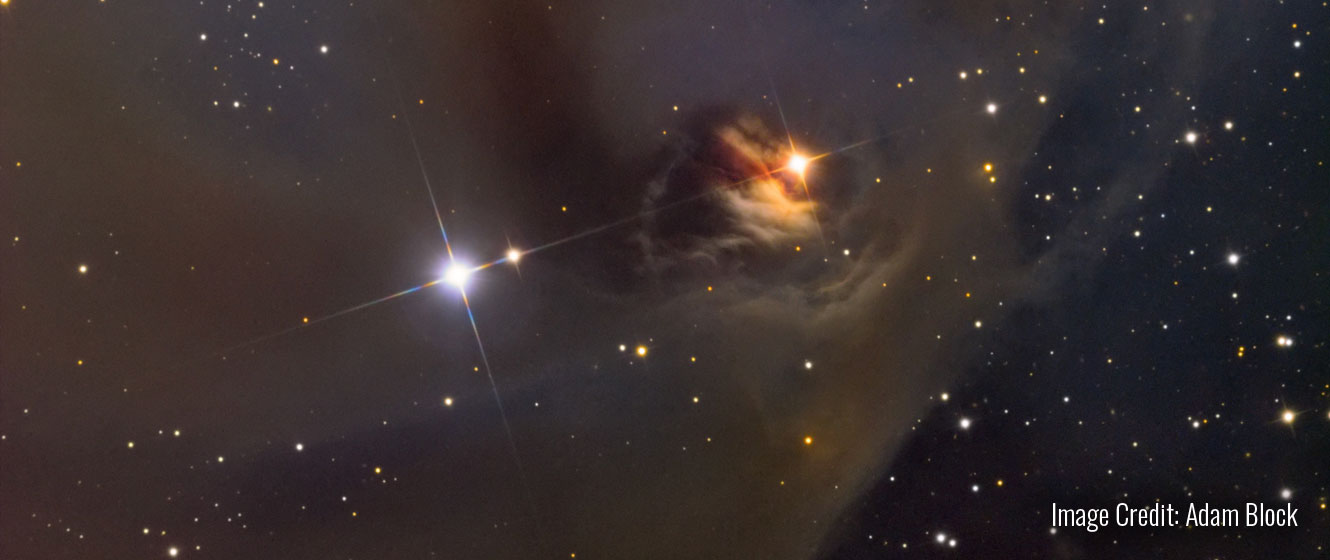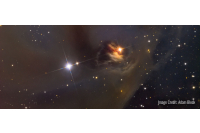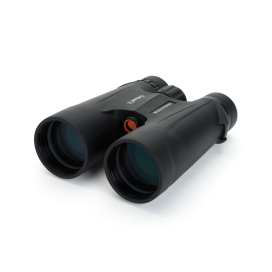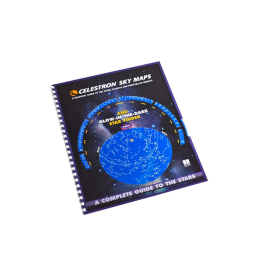
Variable stars have long been recorded in the night sky, ranging as far back as possibly some 3,000 years ago when the bright star, Algol, might have been noticed as dimming by the ancient Egyptians. Variable stars are stars that change in their luminosity over a period of time. Some, like Betelgeuse or Algol, do so quite rapidly. Some stars - such as Cepheid variables - dim on a regular schedule. All stars have some sort of variability to their brightness. Even our own Sun could be considered a “variable” star as it undergoes a regular 11 year solar cycle. This article will cover some of the different variable stars an amateur astronomer can see.

The dimming episode of Betelgeuse, visible here as the orange star in Orion’s armpit. Looking closely, you can see that Betelgeuse is considerably dimmer in the right image vs the left. Photo credit: H. Raab, Wikimedia
Why observe variable stars?
Variable stars are an absolutely fascinating phenomenon to observe. We look at the stars and think that they are always static and unchanging. However, the appearance of the stars can change over time. This was recently, and remarkably, shown in the winter of 2019-2020 when the star Betelgeuse, one of the main stars of the constellation of Orion, suddenly dimmed by a factor of ~3x over the span of a few weeks. Even with the naked eye, it was obvious that Betelgeuse had grown significantly fainter and that the constellation of Orion the Hunter suddenly looked less like a “hunter” and more like a random group of stars in the sky.
Many astronomers are fascinated enough by this phenomenon to spend their nights pointing at variable stars and observing the change in their luminosity with respect to time (also known as stellar flux). Some choose to do this visually, or by taking photos of the stars and using software to measure the star's brightness.
Different types of variable stars
There are four main classifications of variable stars. The most famous is a Cepheid variable, which follows a regular pattern of brightening and dimming. Cepheid variables are useful distance markets in astronomy, as there is a direct relationship between their luminosity and pulsation period. The discovery of a Cepheid variable in the Andromeda Galaxy in 1924 confirmed that the Andromeda Galaxy did not reside in our own galaxy and was instead millions of light-years away.
Then there are Mira variables, usually associated with red giant pulsating stars like Mira & Betelgeuse. Unlike Cepheid variables, Mira variables are not usually regular with their pulsation period & can vary as much as 11 magnitudes in apparent magnitude over the span of several years.
Lastly, there are Eruptive stars (such as nova and supernovae) & eclipsing binaries. While eclipsing binaries are not technically variable stars (although they may have some variability in their brightness), they are the result of two stars transiting one another, producing dips in apparent magnitude. The most famous example of this is the star Algol.
Best variable stars for amateurs to observe
In the Spring skies, we can find the well-known variable Mekbuda in the zodiacal constellation of Gemini. Mekbuda is a cepheid variable and has a pulsating period of ~10 days. The star can vary in brightness from +3.68 to +4.16. This corresponds to a change in brightness of about 1.5x. There is also the star Alpha Herculis in the constellation of Hercules, which varies around 3x in magnitude over the span of ~100 days.
In the Summer skies, we can find Beta Lyrae in the constellation of Lyra. Beta Lyrae is an eclipsing binary, meaning that from our perspective the stars appear to eclipse one another. Beta Lyrae undergoes a transit every ~13 days and will drop in apparent magnitude from +3.2 to +4.4. We also can find Eta Aquilae in the constellation of Aquila, another variable star that will undergo a change in brightness from +3.5 to +4.3 over a period of ~7 days.
Looking at the Fall skies, undoubtedly the best variable star is Algol in the constellation of Perseus. Like Beta Lyrae, Algol is an eclipsing variable. Its apparent magnitude changes from +2.2 to +3.39 every 2.86 days. This makes Algol by far one of the best variable stars to observe with the naked eye. We also can find the star Mira, a giant star in the Big Dipper known as a “pulsating variable”. Mira’s apparent magnitude can vary anywhere from +3 to +4.9 over the span of a few years.
And finally, in the winter skies, we can find the most newsworthy variable star: Betelgeuse in Orion. Although astronomers have long known that Betelgeuse was a variable star, until winter of 2019, many amateurs might not have even guessed that Betelgeuse could vary dramatically in its visibility. However, Betegeluse underwent a dramatic and unexpected change in its apparent magnitude, dropping from +0.5 to +1.7, likely as a result of dust orbiting the giant star dimming the light. Then there is Lambda Tauri in the constellation of Taurus, another eclipsing binary with a period of ~4 days.
While we’ve reviewed a few variable stars, this is by no means an exhaustive list. There are dozens more variable stars that can easily be observed by amateur astronomers, such as Delta Cephei (where the Cepheid Variable class gets its name), Mu Cephei, Eta Geminorum, and many more.
Observing variable stars
Observing visual stars is a pretty straightforward process. As mentioned, the variability with many can be plainly seen with the naked eye. However, if you’re looking to record the apparent magnitude of the star as it changes over the span of several nights, the best method is to check its brightness against nearby stars.
For example, you can observe with the naked eye a particular night that Algol is nearly as bright as Mirfak. You can deduce that the apparent magnitude of Algol is ~+2.0. However, when Algol is at its minimum, it is noticeably dimmer than Mirfak and might be comparable to nearby Gorgonea Tertia. You can then deduce that Algol has an apparent magnitude of around +3.5. Naturally, this method of observing is very uncertain, as the human eye is a poor gauge of brightness, especially with stars that are different colors, and some uncertainty must be assigned to these observations.
A more precise method to measure variable stars is through a process known as photometry. Photometry enables your computer to precisely measure the brightness of a star over a period of time. Most professional astronomers use a CCD sensor for this purpose, however, you can use a CMOS sensor to more accurately measure the brightness of a star. A great CMOS camera to use is the QHY294C. The American Association of Variable Star Observers (AAVSO) offers software called “VPhot” which is an online tool enabling one to upload their .fts files, provided you are a member of AAVSO.
Should you wish to contribute to citizen science through this method, we recommend checking out the Variable Star Observing Program, where you will learn more about how to more precisely measure variable stars. We’d also strongly recommend checking out the American Association of Variable Star Observers (AAVSO) for more information on how to contribute to citizen science in your backyard.

Questions? Contact Us!
Stumped on which telescope is the best fit for your viewing of variable stars? Send a message to our non-commissioned product advisors! Our team of telescope experts are happy to point you in the right direction.
Click the arrow above to see MLA, APA, and Chicago Manual of Style citations.
MLA:
Denny, Kyle. "How to Observer Variable Stars," AstronomyHub, High Point Scientific, 14 Aug. 2023, https://www.highpointscientific.com/astronomy-hub/post/how-tos/how-to-observe-variable-stars.
APA:
Denny, K. (2023, August 14). How to observer variable stars. High Point Scientific. https://www.highpointscientific.com/astronomy-hub/post/how-tos/how-to-observe-variable-stars
Chicago Manual of Style:
Bibliography:
Kyle Denny. "How to Observer Variable Stars," AstronomyHub (blog), High Point Scientific, August 14, 2023. https://www.highpointscientific.com/astronomy-hub/post/how-tos/how-to-observe-variable-stars.
Footnote:
Kyle Denny, "How to Observer Variable Stars," AstronomyHub, High Point Scientific, August 14, 2023. https://www.highpointscientific.com/astronomy-hub/post/how-tos/how-to-observe-variable-stars.
This Article was Last Updated on 08/14/2023
















